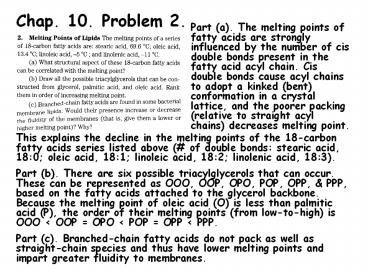Chap. 10. Problem 2. - PowerPoint PPT Presentation
Title:
Chap. 10. Problem 2.
Description:
This explains the decline in the melting points of the 18-carbon fatty acids series listed above ... (b). There are six ... Water-soluble vitamins are subject to ... – PowerPoint PPT presentation
Number of Views:62
Avg rating:3.0/5.0
Title: Chap. 10. Problem 2.
1
Chap. 10. Problem 2.
Part (a). The melting points of fatty acids are
strongly influenced by the number of cis double
bonds present in the fatty acid acyl chain. Cis
double bonds cause acyl chains to adopt a kinked
(bent) conformation in a crystal lattice, and the
poorer packing (relative to straight acyl chains)
decreases melting point.
This explains the decline in the melting points
of the 18-carbon fatty acids series listed above
( of double bonds stearic acid, 180 oleic
acid, 181 linoleic acid, 182 linolenic acid,
183). Part (b). There are six possible
triacylglycerols that can occur. These can be
represented as OOO, OOP, OPO, POP, OPP, PPP,
based on the fatty acids attached to the glycerol
backbone. Because the melting point of oleic acid
(O) is less than palmitic acid (P), the order of
their melting points (from low-to-high) is OOO lt
OOP OPO lt POP OPP lt PPP. Part (c).
Branched-chain fatty acids do not pack as well as
straight-chain species and thus have lower
melting points and impart greater fluidity to
membranes.
2
Chap. 10. Problem 4.
The five-carbon isoprene units in geraniol,
farnesol, and squalene are circled in the diagram.
3
Chap. 10. Problem 7.
Hydrophobic Units Hydrophilic Units
a. 2 fatty acids phosphoethanolamine
b. 1 fatty acid sphingosine phosphocholine
c. 1 fatty acid sphingosine D-galactose
d. 1 fatty acid sphingosine oligosaccharide head group
e. steroid nucleus alkyl side chain hydroxyl group at position-3
4
Chap. 10. Problem 10.
Grease produced by cooking is predominantly
animal fat consisting of triacylglycerols. The
ester linkages in triacylglycerols are readily
hydrolyzed by treatment with strong base (e.g.,
sodium hydroxide). Treatment with strong base
produces glycerol and 3 fatty acids from a
triacylglycerol. These hydrolysis products are
much more soluble in water than triacylglycerols
themselves. The cleavage products can be washed
away with water.
5
Chap. 10. Problem 16.
The two products produced by phospholipase C
cleavage of phosphatidyl 4,5-bisphosphate are
diacylglycerol and inositol 1,4,5-trisphosphate
(IP3). Both of these cleavage products are second
messengers that activate intracellular pathways
used in vasopressin signaling (Chap. 12).
Diacylglycerol is a hydrophobic lipid that
remains in the cytoplasmic membrane in which the
cleavage event occurs. IP3, on the other hand, is
very polar and is released into the cytoplasm of
the cell.
6
Chap. 10. Problem 17.
Water-soluble vitamins are subject to excretion
by the kidneys on a daily basis. Fat-soluble
vitamins (A, D, E, K) are lipid-soluble and thus
partition into fat stores in body tissues. These
tissues therefore provide a reservoir of
fat-soluble vitamins that can serve the
individual for months.
7
Chap. 10. Problem 20.
Silica gel is a polar matrix than binds polar
lipids more strongly than nonpolar lipids. Thus
nonpolar lipids will elute from a silica gel
column earlier than polar lipids. Based on
consideration of the hydrophobic-hydrophilic
balance for the mentioned lipids, cholesteryl
palmitate and triacylglycerol should elute from
the column first. Cholesterol and n-tetradecanol
being somewhat more polar due to their free
hydroxyl groups would elute next. The neutral
phospholipids phosphatidylcholine and
phosphatidylethanolamine would then elute,
followed by sphingomyelin, which has a slightly
greater content of polar functional groups.
Finally, the negatively charged
phosphatidylserine and palmitate would elute from
the column. Of these two lipids
phosphatidylserine would elute first because it
has a lower charge-to-mass ratio than palmitate.































